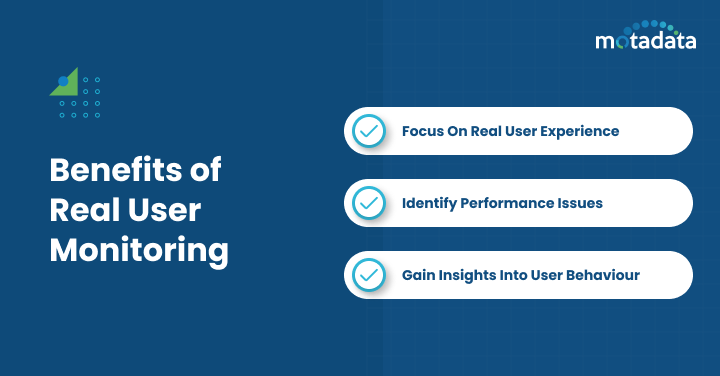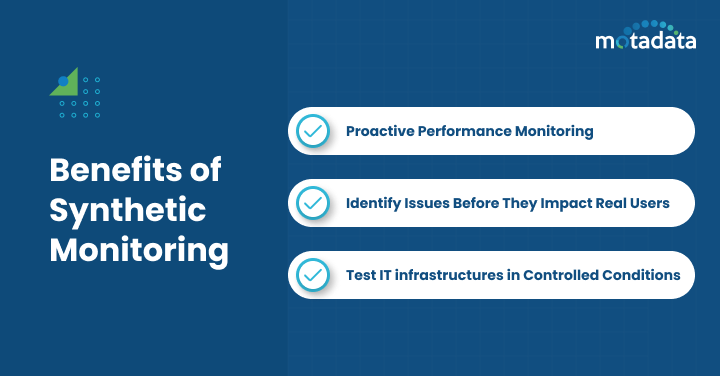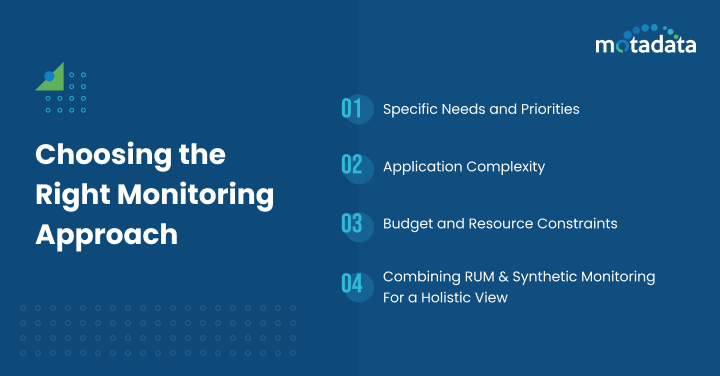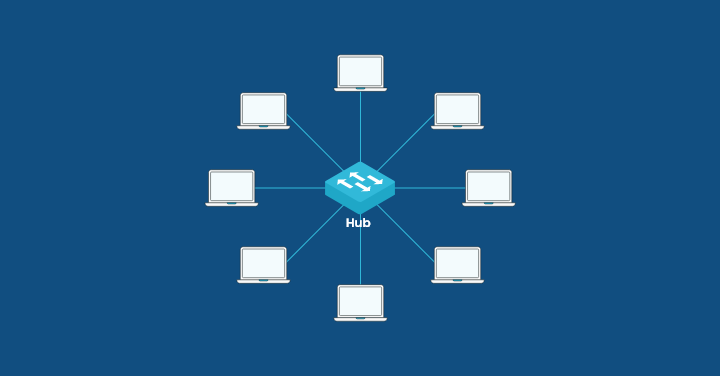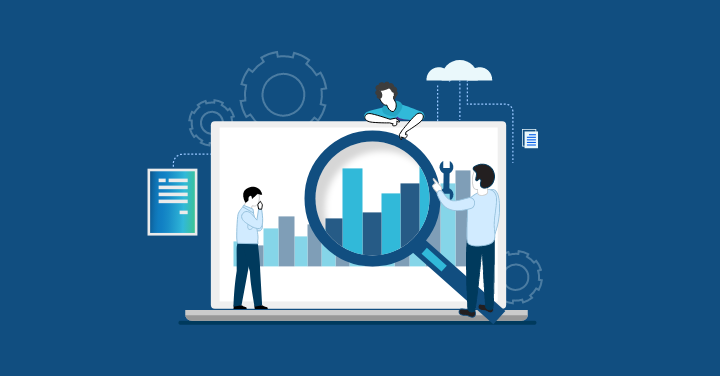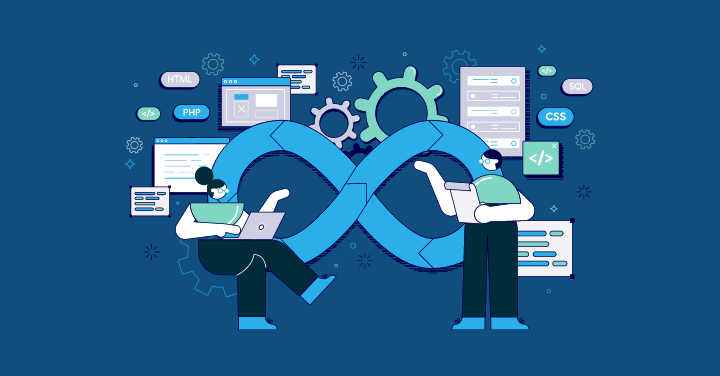Application slowdowns or outages interrupt the user experience and web performance. This significantly impacts brand reputation, leading to customer churn and a heavy dent in the competitive edge.
This is where Application Performance Monitoring (APM) comes in.
APM tracks application performance to ensure a positive user experience. Real User Monitoring (RUM) and Synthetic Monitoring are two approaches to analyzing your app’s performance and the digital experience they provide.
While RUM provides insights based on user interactions, synthetic monitoring simulates user behavior, enabling teams to proactively identify app performance issues based on real user measurement before they impact the user experience in the real world.
This post discusses RUM vs. Synthetic Monitoring, including their approach, benefits, monitoring strategy, and differences, with relevant examples.
Understanding Real User Monitoring (RUM)
RUM captures how users interact with a web application or a mobile app across different geographies.
It collects data related to performance metrics such as page load times, error rates, and user interactions.
These top-rated methodologies track the user’s experience of an application in real time, using real user data and helping stakeholders identify app performance issues.
Here’s how RUM works:
1. Capturing Real User Interactions
RUM embeds a small JavaScript code snippet into the app pages. This code is triggered when a user visits the app or site and captures information about user interactions.
2. Analyzing User Experience Data
Real User Monitoring collects a wide range of user experience data, such as clicks, errors encountered by users (broken links, failed requests), page load times, etc.
3. Provides Insights Into User Experience
The monitored data is streamed from the app to data stores, which can be visualized using analytics and reporting.
Benefits of RUM
The benefits of RUM are as follows:
1. Focus On Real User Experience
RUM captures data from end user sessions, offering insights into user experience.
For instance, if a website has specific issues related to slow load time, RUM can provide insights into how users in a certain location are affected.
This can help you optimize the website for specific user segments, improving user experience.
2. Identify Performance Issues
RUM identifies real-time performance issues. It tracks error rates and page load times and helps teams spot issues that impact user experience. Suppose you launch new features in a fitness app.
RUM can detect user interactions with these new features to identify issues before they impact user experience.
3. Gain Insights Into User Behavior
Rum provides valuable insights into user behavior. For example, you can use RUM to track how users interact with your blog posts and landing pages.
You can analyze this data to find which CTAs or content work better than others.
Understanding Synthetic Monitoring
The synthetic monitoring technique simulates user interaction within an application to assess its performance.
Unlike RUM, synthetic monitoring executes scripted transactions to test the app proactively. This helps you spot issues before they affect the real app users.
Synthetic monitoring provides strategic insights into IT systems, infrastructures, and pipelines. It identifies associated issues, ensuring managers fix them before customers understand. Here’s how it works:
Simulating User Interactions Using Scripts
Synthetic monitoring uses scripts to simulate typical user actions within an application, such as navigating through pages, checking pricing plans, downloading content, and completing transactions.
By running these scripts, you can identify users’ roadblocks when taking the same action on the website or application.
For instance, a bank’s website can run a synthetic monitoring script that logs in, checks account balances and transfers funds.
Running the script regularly allows the bank to solve issues before customers face them.
Monitoring Application Performance from a Predefined Perspective
Using synthetic monitoring, you can test app performance from specific browsers, locations, and devices.
This helps you understand how the app performs under different user scenarios.
For instance, if you’re a global eCommerce company, you can use synthetic monitoring to test your website from different locations.
This will show how the website load times and latency vary by country.
Providing Insights Into Baseline Performance and Potential Issues
With synthetic monitoring, you can establish and measure key metrics such as uptime, error rates, and response times.
This helps you detect deviations from the established metrics and identify potential issues.
For instance, if a synthetic monitoring script that tests page load time reports a sudden increase, you can immediately investigate if the rise in page load time happened from recent code deployment or third-party integrations.
Benefits of Synthetic Monitoring
The benefits of synthetic monitoring are as follows:
1. Proactive Performance Monitoring
Continuous testing of applications using synthetic monitoring scripts helps you identify problem areas proactively. It allows you to take swift action to address issues before they impact user experience.
2. Identify Issues Before They Impact Real Users
Synthetic monitoring helps you find and fix potential errors before they affect users, ensuring enhanced user experience.
Suppose synthetic monitoring spots slow response time for a critical app function. The development team can analyze and fix the issue before users face transaction delays.
3. Test Application Behavior Under Controlled Conditions
Companies can use synthetic monitoring to test IT infrastructures and app behaviors under controlled environments where the variables are known.
You can monitor how the app performs in each scenario by replicating different scenarios. For instance, a SaaS company can use the technique to simulate high traffic on its website during a webinar.
This helps them ensure that the infrastructure can handle peak loads, ensuring quality performance.
RUM vs. Synthetic Monitoring: A Differential Guide
| Aspect | RUM | Synthetic Monitoring |
|---|---|---|
| Focus | Focuses on capturing real user interactions/ sessions to analyze app behavior | Focuses on replicating user sessions to analyze app performance |
| Data collection | Passive data collection. It does initiate tests but collects real user interaction data | Active data collection. It proactively tests apps to spot issues before real users face them |
| Insights provided | Gives a holistic view of user experience. It captures metrics like session duration, bounce rate, conversion rates, etc. to measure user satisfaction | Provides insights into system performance and potential issues. It focuses more on technical performance metrics like response times, availability, reachability, etc. |
| Use cases | Identifies user-facing issues. It provides real-world insights into user experiences, ensuring app optimization | Proactively monitors app performance to spot potential bottlenecks before they impact users |
Choosing the Right Monitoring Approach
When choosing between RUM vs. synthetic monitoring, consider these factors to see which technique aligns the best with your use case.
1. Specific Needs and Priorities
Consider RUM if you’re focused on capturing real user interactions with your application or website.
RUM tracks user sessions within the software to provide insights into user behavior and potential roadblocks they are facing.
Conversely, use synthetic monitoring to identify potential bottlenecks in your app or website before they affect users.
For instance, if you plan to roll out a new feature, use synthetic monitoring to test whether the feature functions properly before providing access to users.
2. Application Complexity
RUM is ideal for complex applications with multiple workflows, interactions, and user paths. It provides insights into how real users navigate within the application.
Conversely, synthetic monitoring is for simpler apps with specific transactions that must be tested regularly.
For example, a global eCommerce company like Amazon with different user flows can use RUM to capture user sessions across the site.
However, simple banking apps with limited user flows can use synthetic monitoring to test the features consistently.
3. Budget and Resource Constraints
In RUM vs. synthetic monitoring, RUM is more effective in the long term, while synthetic monitoring is for the short term.
When comparing costs, synthetic monitoring requires more resources and budget when you test multiple locations or extensive scenarios.
RUM, on the other hand, is more cost-effective as it covers a wider range of user insights.
4. Combining RUM and Synthetic Monitoring For a Holistic View
While you can choose between the two techniques, RUM, and synthetic monitoring both address different monitoring aspects.
Synthetic monitoring proactively identifies issues and is more effective for shorter-term problem-solving. RUM provides insights into genuine user experiences and challenges.
Integrating both helps you get a holistic view of app performance and plan a well-rounded strategy for app optimization.
Use Cases and Real-World Examples
Now that you know the differences between RUM and synthetic monitoring techniques, here are examples of how they are applied in real-world scenarios.
1. RUM
The most common example of RUM is Google Analytics, which monitors user interactions and provides real-time insights. You can monitor clicks, page views, session durations, traffic sources, etc.
For instance, using RUM, you can identify if a high-traffic page loads slowly, impacting user experience. Say your product demo page has the highest traffic of all web pages.
Monitoring the page, you find that users experience slower load times during peak hours, specifically when viewed from mobile devices.
Analyzing RUM data can give you details on the causes of slow loading times, whether due to large videos, images, or other infrastructure issues.
2. Synthetic Monitoring
Synthetic monitoring has several use cases. For instance, you can check user login or add items to shopping carts. A synthetic test simulates the login page and logging into the account.
It further replicates browsing products and adding them to the cart. This test ensures that the user flows function well and there are no roadblocks in the process.
Let’s say you plan a webinar to reveal your latest major product updates. You can use synthetic monitoring to replicate the user interactions on your website.
Build scripts to mimic the expected traffic patterns during the event and test crucial user flows like demo signups and account creation.
The synthetic tests reveal if the website can handle high traffic. Does it have a slower response time than required under the simulated traffic load?
Does it crash? This information helps teams to fix these issues and prepare the website for the event.
What is the Future of Application Performance Monitoring?
The IT industry employs APM techniques to improve customer experience.
Many companies integrate RUM and synthetic monitoring to achieve comprehensive performance analysis, providing a holistic approach to monitoring, optimizing, and enhancing user interactions and overall system performance.
Convergence of RUM and Synthetic Monitoring
Combining RUM with synthetic monitoring means gaining insights into user activities while testing apps in controlled environments to identify potential bugs.
This way, you track user interactions, fix real-time issues, and proactively spot problems before users face them. Moreover, you can also ensure consistent testing and performance benchmarking.
The Potential Role of AI & ML in Enhancing Visibility
AI and machine learning are crucial in advanced app performance analysis, anomaly detection and better overall visibility.
With AI, you can collect vast amounts of data for RUM and synthetic monitoring, using them to predict user behavior and performance issues.
Moreover, ML models can also detect anomalies in real-time. The system can send alerts on detecting issues, ensuring the team addresses them immediately.
Conclusion
While synthetic monitoring allows consistent testing, it fails to capture the variety of user interactions within an app. This is where you need RUM, which gives you details about user interactions in real time.
Both RUM and synthetic monitoring are effective in different real-world scenarios.
However, you must know which technique works better in a given situation. This will help you ensure user satisfaction and stay ahead of the competition.


